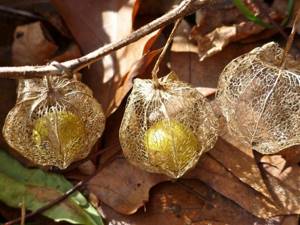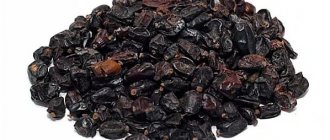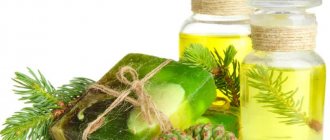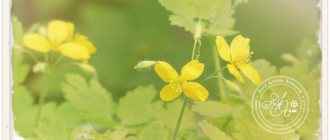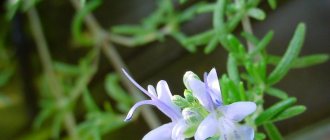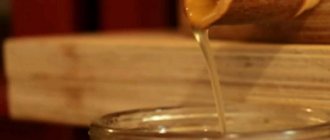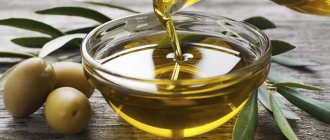Physalis is a rather original plant that looks like a flower, although in fact it is a fruit and belongs to the Solanaceae family. It has a number of beneficial properties, therefore it is used in food and as a medicinal product. But it is worth understanding that we are talking specifically about the edible variety of physalis, since there is also a decorative species.
In total, there are more than one hundred and twenty varieties of this plant. Each of them has its own characteristic feature, in particular the taste characteristics, appearance and, naturally, the timing of fruit ripening.
Why do superstitions prohibit dried flowers?
There are several reasons for this that explain the essence of the problem. One of them says that dried flowers take luck, money and health from the house. Whether you should trust such a sign is a purely personal matter for each of us, but if you have even the slightest doubt about this, it is better to play it safe and get rid of the “dead” flower.
Some superstitious individuals claim that a dried plant not only brings misfortune to the house, but can also give family members serious illnesses. And some cases can even be fatal. In addition, there is a belief that dried flowers bring betrayal from loved ones and separation from them.
How to eat physalis fruits
Fresh berries are the most useful. Therefore, it is best to eat them raw, as they contain the greatest amount of vitamin C.
In addition, I can preserve the fruits and make caviar and jam from them. Berries are dried, candied fruits, marshmallows, and marmalade are made.
Before eating the berries, they need to be doused with boiling water. This need arises due to the fact that they are covered with a sticky layer that needs to be washed off.
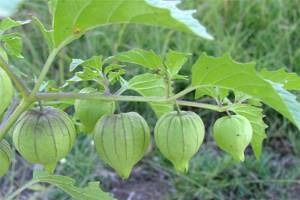
How to scare away misfortunes?
Surprisingly, along with the sign that brings illness and failure, humanity has come up with a kind of antidote to this phenomenon. This miracle remedy allows you not only to disperse the gloomy clouds hanging over your family, but also to preserve the desired bouquet in the house.
Firstly, few people realize that the ancient superstition about dried flowers is not interpreted entirely correctly. Thus, it is not the entire plant that poses a threat to humans, but only a drooping bud. In the old days, many grandmothers, doing a similar thing, prepared dried flowers to ward off evil spirits and the evil eye. This phenomenon has survived to this day for use in mystical rituals, but you are unlikely to want to leave a huge bouquet of roses without buds at home. There is a magical solution for this too. Some claim that if you wrap a black wool thread around a vase, it will repel negative energy and protect your home. Others believe that the most effective solution would be holy water and the Lord's Prayer. It is enough to sprinkle dried flowers while reading a prayer to yourself. But the ritual must remain secret.
Another amazing way to ward off the misfortunes caused by dried flowers is to do something. To do this, you need to step across the threshold, entering the apartment, with a dried flower in your hands through a representative of the cat family, or throw a leather belt at your feet. Such a seemingly ridiculous decision, according to popular wisdom, will save the bouquet from the negative impact on you and your family.
1. Flowers in pots always reflect the state of their owners.
If you care about flowers, they will always tell you with their condition.
2. Tanned skins in the home (shop, office...) contribute to successful trade, increase capital, and also protect property. Only the skins need care and attention.
3. Dried flowers, placed in a vase and creating a unique bouquet, promote well-being, wealth, health and comfort. They neutralize negative energy. True, in Russia today there is a completely erroneous opinion that dried flowers cannot be stored in the house. Flowers and herbs hung in bunches in a certain place or in utility rooms further improve the energy of the house.
Remember, before in every village house, bunches of herbs were suspended from the ceiling or tucked behind the ceiling. Herbs and flowers kept in the house and allowed to dry naturally release health energy that protects the house during periods of epidemics.
4. Animal figurines (not grotesque ones) protect the house from misfortunes, and also store financial wealth. Dogs, bears, tigers, dragons protect you. Figures of soldiers, warriors, and nesting dolls, repeating each other and placed in a row, are an excellent cleanser. Elephants, following each other and decreasing in size from larger to smaller, are a universal cleaner. It is no coincidence that elephants used to stand on shelves in many homes.
5. Pillows are amulets of marital love. If the pillows are tapestry, with an embroidered pattern, bright, they protect against separation from your loved one and focus attention on your partner. If there are flowers on the pillows, this is a talisman of health; if images of people, animals - protect from dangers; if the image is of landscapes, buildings, it helps your endeavors to be successful.
WHAT NOT TO HAVE IN YOUR HOUSE?
Our apartments are full of a wide variety of objects and things - from purely functional to decorating the interior. But not everything is good to have in the house.
1. Old, worn slippers should not be kept in the house - they attract negative energy. If the slippers are torn, they must be removed from the apartment. 2. Also, you should not store torn, unusable clothes in the house. Always evaluate old shoes and clothes based on whether you will still wear them. If you don't, throw it away.
3. Dishes with cracks, chips, or defects resulting from use disrupt the energy of food, making it dangerous to human health. No matter how much you like the dishes, if they crack or a piece breaks off, such dishes need to be thrown away. The plate (bowl) symbolizes family. Flaws in the dishes indicate possible problems in the relationship.
4. Living plants whose stems cover the walls cannot be inside the house. Climbing plants attract various diseases. If the plant is located outside the house, on the outside, then this is only beneficial - your house is protected. But if such a plant is inside the house, then its growth should be organized in such a way that the climbing stems form a ball in the pot. You can install a wire frame. 5. Keeping reeds in the house is dangerous. Dried, they attract misfortune and portend illness and death. Feather grass will bring similar troubles if you decorate a room with it. It foreshadows widowhood.
6. At the same time, you can have other dried flowers in the house; most of them process negative radiation, protecting residents from diseases. 7. Flowers such as pansies should not be grown at home. They are traditionally planted near graves.
8. It is appropriate to place coniferous branches in a vase only during the New Year holidays. It is bad luck to keep these branches in your apartment during the rest of the year. 9. But begonia - a symbol of family well-being - will always help balance the situation. 10. Never bring a gifted palm tree into your home - this will lead to great grief.
Surely everyone knows that wealth is attracted by such indoor plants as crassula and geranium (pelargonium), especially if coins are buried in the ground in which they grow.
1. Crassula for wealth
On the full moon, before planting the plant, sprinkle the pot with holy water. Take a lit church candle in your right hand and pass it over the pot 3 times with the words: “Mother Earth, accept my tree, feed it with juices, give it your strength, reveal your riches to it! Father sun, warm my tree with your rays, give it warmth, light and life, so that its leaves fill up and bring prosperity to the house! Water-water, wash my tree with your streams, give it dew, give it gold and silver drops, let silver and gold remain in my house! Brother wind, fan my tree with your living breath, drive away misfortunes and illnesses from it, bring wealth and prosperity into my home! And may my wealth increase with every new leaf, with every new twig! Let it be so. Amen!"
Pour some soil, put three 50-kopeck coins and plant a sprout. Water it with the words: “Little fat sister, grow up, be a man, give me your monetary power: for trade, for income, for a tight bag, for full bins! Just as your foliage is growing every day, my money is not transferred!”
If you purchased a fat plant growing in a pot, you will not need the first spell, but repeat the second every time you water the plant. It would be nice to place the pot on a red napkin, under which there should be three bills.
2. Money geranium
While watering the geranium, repeat the following words many times: “Grow, flower, grow, curl. Come, money, accumulate, multiply.” Or say three times: “You grow, and I bloom in wealth.” This is my will. Let it be so!"
3. Wheat tree
To grow an original wheat tree that attracts the energy of wealth, you will need:
Six grains of wheat, preferably durum varieties (such varieties germinate best); a new light-colored ceramic flower pot with a capacity of a liter or more; soil from a wheat field, vegetable garden, or large, well-tended flower bed with white flowers (avoid soil from flower beds with red, burgundy, or purple flowers); yellow coins - 30 pieces (plus another 3-7 coins, which will be needed later for decoration); water that has been standing for 24 hours (the ideal option is rainwater mixed with morning dew: add a few drops of dew to a glass of water and you will get miraculous moisture; however, ordinary water is also quite suitable).
Plant each seed separately with your left hand. Planting depth is two to three centimeters. All grains should be located close to each other, almost in the same place, so that when they emerge, they merge into one massive trunk.
Water the soil immediately after sowing. In the future, watering should be done every three days. While growing wheat, talk to it - this is an important rule. Fill your magic tree with the energy of your desires. Love it so that it feels your care and warmth.
Place the pot on a windowsill on the sunny side (can be in the living room, kitchen or bedroom). The plant must be given the opportunity to bathe in sunlight. Protect the tree from prying eyes and under no circumstances allow strangers to touch it.
When the sprouts reach a length of approximately 10-15 centimeters, place six yellow coins at the bottom of the vessel where the irrigation water settles. Let the coins remain there until the entire growing process is completed. This water is an excellent fertilizer for a growing money tree.
When the wheat gains strength and ripens, very carefully remove it from the pot along with the rhizome. Tie the stems together with yellow (golden) thread or decorative thin rope and place in a vase without water. First place a few yellow coins at the bottom of the vase (the amount must be even). The first six grains that fall from the ears of wheat can be used to grow the next money tree.
4. Dollar Tree
The so-called dollar tree has powerful magical powers for enrichment, attracting good luck in the financial sphere and activating monetary energy. Its scientific name is Zamioculcas. This unpretentious exotic plant is sold in almost all flower shops. Unlike the wheat tree described above, it attracts only dollars to its owner. By the way, they say: the faster the tree grows, the sooner things will get better. By the way, it can reach a height of a whole meter!
It is better to choose a pot for zamioculcas that is wide and not too high, the soil is moisture-absorbing and breathable. It is not at all necessary to place the dollar tree in the southeast of the house (that is, in the Wealth sector). It will show its power in any part of the room. The plant does not like bright light, so it needs to be placed at some distance from the window, but in no case on the windowsill.
To activate the tree and charge it to work, you need to attach one dollar to the flowerpot, and it doesn’t really matter whether it is unfolded or rolled up into a tube (bow). But it is important that the pyramid depicted on the bill is visible. It is desirable that its tip is directed upward.
One cent should be placed under the pot or hidden in the ground. Such a coin will feed the flowerpot with energy, which it will give through its leaves to you and your home. This, in turn, will affect the enrichment of all residents of the house.
You need to water Zamioculcas not with plain water, but with money. It’s quite simple to prepare: put a few cents in plain water for 15-20 minutes. Water the plant immediately afterwards.
5. Bamboo prosperity
An excellent money tree is obtained from the “lucky bamboo” (Dracaena sanderiana). This plant attracts good luck in all areas of life, including material ones. Strengthens the movement of positive energy, harmonizes space. Place five zigzag stems in a tall vase and they will multiply your financial flow.
And if you attach Chinese coins on red strings or bells to the stems, there will be even more money. In addition, to enhance the magical properties, the stems are tied with golden-yellow ribbons. The main thing is to avoid direct sunlight on the dracaena, otherwise it will quickly turn yellow and wither. Helpful advice: change the water in the vase more often - every other day, or even every day.
6. Linden tree
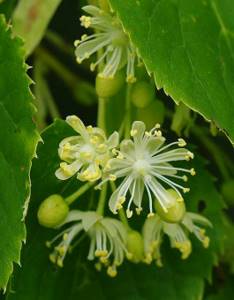
On the young moon, go to the linden tree and ask it for permission to take three branches to improve your well-being. If the wind does not rise and the leaves do not rustle, this means the tree agrees to help you. Otherwise, find another linden tree. Pluck the branches, thank the linden tree for its help and leave some sweets (candy, cookies) on the ground as a gift. Bring the branches home and place them in water. Meditate on the linden tree in the first half of the day (before noon), whisper or mentally talk about your desire to get rich. After 10 days, the branches can be dried, stored for a year, then burned.
7. Money decor
In principle, you can make a money tree from almost any plant with green leaves growing in your home. According to Feng Shui, all plants are associated with the element of Wood. There are a great many ways, the main thing is the right attitude and faith that everything will work out for you. For example, on a waxing moon, roll three real or printed banknotes into a tube and simply stick them into the ground with the plant. Another option is to cover the pot with banknotes or their imitation. Third - throw a few coins on the ground in the pot.
If you are not a fan of indoor plants, take a photograph or image of a tree and stick or attach coins in any other way (for example, using plasticine) on its branches. Hang this picture in the left corner of the room farthest from the front door.
Dried flowers in many traditions have been associated with illness, wilting and death, but is it really dangerous to keep them at home? We propose to deal with this issue in today’s article.
Dried flowers, whatever one may say, lose their former aesthetics
unless the primary goal was to directly dry the buds for further
decorative crafts
. Dried flowers are often used to make tea: . There are also separate techniques for flower arrangements based on dried flowers. Our mothers often kept their fathers' first flowers between the pages of books in order to return to the romantic events of their youth years later. Remember, in the first grades of school we learned to create applications with dry sheets and flowers?
For many, dried flowers will remain simply dead plants, to which no one will pay attention in the house for a couple of days, for others - the basis for handicrafts, and for the rest - a terrible omen.
Varieties of edible Physalis
Before planting edible physalis, you need to choose the most suitable variety. The most common varieties of Physalis edible in cultivation are:
Peruvian
A berry variety with a pleasant sweetish taste and aroma. Used mainly for making desserts.
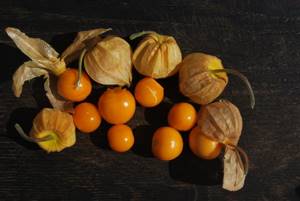
Marmalade
A very shade-tolerant plant native to Mexico. The fruits of physalis are consumed raw for canning, as well as for the usual jam and preserves.
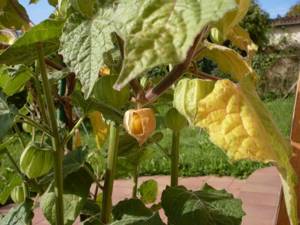
Pineapple
An interesting botanical species, differing from the classic strawberry variety in its small fruits. The variety ripens early and produces a harvest at the end of June - this is approximately several months after emergence. Unripe fruits are pale green, and already at the ripening stage they gradually change color to yellow. When fully ripe they acquire a creamy hue. They taste sweet, with a pleasant aroma. They are used to make candied jam. Can also be used fresh. The berries of this variety of physalis are small and taste like pineapple.

Izyumny
When dried, the variety becomes similar to raisins. It is used not only dried and dried, but also fresh. Has a citrus taste. The variety matures in approximately 100 days and is considered early ripening. The bushes grow spreading and branch very strongly. The fruits grow oval in shape, with a yellow-golden hue. The weight of each fruit is approximately 10 g. It smells pleasant and is very tasty with an unusual sourness.
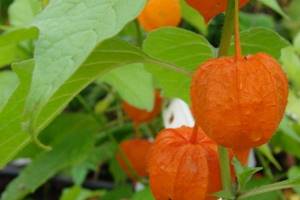
Moscow early
Vegetable variety, used successfully for preservation. Early ripening fruits weighing up to 80 g. An early variety of plant with large fruits with a yellow tint. Popular due to its good harvest. Used for making pickles, pickling, salads, jam, caviar, candied fruits, marmalade and preserves.
Mexican tomato
The most common among vegetable varieties. The bushes are tall, the fruits have a yellowish tint. Used in salads and jams.
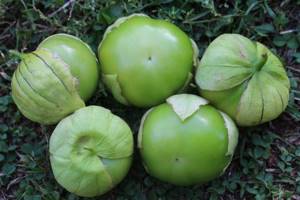
Ground Gribovsky
A productive and cold-resistant variety. The fruits have a greenish tint and are mid-ripening.
Korolek
The variety ripens quite early and belongs to the vegetable crop. The resulting harvest is used in the production of vegetable caviar, as well as to create jam, preserves, candied fruits and even dry wine. Ripe fruits have a pleasant taste, smell and are very juicy. They have a round shape and a yellow tint. The average growth indicators of the Kinglet are from 60 to 80 cm, the branching indicators are average. The species has large plum-colored fruits and a very unusual purple border. The truly unique taste allows the variety to be used for making jam and preserves.
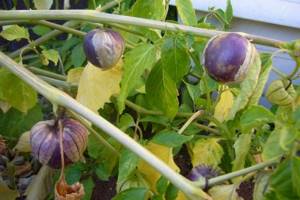
Gold placer
An early ripening plant with very low bushes, no more than 35 cm. They are grown only by seedlings; the plant will not grow in outdoor conditions. It has a golden hue and fruits weighing an average of 7 g.
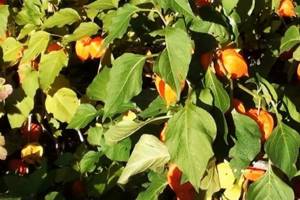
Strawberry
The plant does not require much care, tolerates frost and shade well, and very rarely gets sick. The height of the stem does not exceed 40 cm. The fruits are medium-sized, orange in color with a noticeably pronounced strawberry aroma. Most often used for making delicious jam or for drying raisins.

Sugar "Raisin"
A variety with very small fruits, ripens early and has a wonderful taste and smell. You can eat both fresh and processed fruits. Most often it is used to make raisins.
Vegetable confectioner
It can be called a mid-early variety. It has bright purple fruits. To become even brighter, they are laid out in the sun. Consumed fresh and processed.
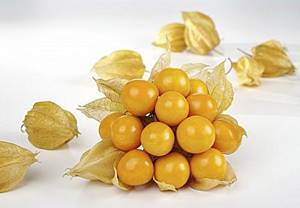
Tomatillo
Mid-season variety with very good yields. He belongs to the Mexican family. This physalis grows yellow and yellow-lilac fruits with streaks of shades.
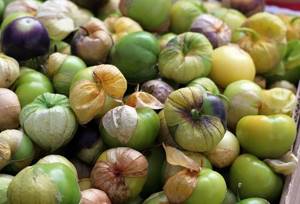
Signs about dry indoor flowers in the house
According to popular beliefs, dried flowers should not be kept at home, as they steal youth and strength.
It is believed that, just as health leaves the plants themselves, we also lose ours by leaving dry flowers in a vase. Firstly, water with dried flowers begins to rot, spreading an unpleasant odor. This moment alone can cause discomfort. Secondly, rot, which is actively forming.
If dried flowers are a magnet for misfortune and misfortune in the house, then why do villages still practice drying bunches hanging in the house? You can, of course, defend farmers by saying that they use exclusively medicinal herbs, which a priori should help people, but dried flowers remain dry flowers in any case. Listening to beliefs and following them is everyone’s business, but you need to approach understanding the legend wisely.
So, let's look at why you can't store dried flowers at home:
- They attract misfortune;
- Can cause death;
- Will lead to the loss of a loved one;
- You will lose money;
- Loss of family well-being;
- Disease;
Brighten up a negative impression and end on a positive note, forgetting about flower vampirism
you can remember how beautiful dried medicinal flowers are.
What flowers can be dried:
- Lavender;
- Chamomile;
- Mint;
- Tansy;
- Thyme;
- Sagebrush;
- Oregano;
Don’t forget that on church holidays we bring blessed flowers into the house and leave them for protection
, and what about herbariums of autumn leaves and dried flowers that we use for tea? The only thing you need to worry about is the dust that accumulates on dried flowers. We cannot wipe them without disturbing the structure, so we often leave them unattended. Dust particles cause allergies, make breathing difficult, and transmit bacteria.
Feng Shui to protect dried flowers
You can place dried flowers in the kitchen or bathroom
. According to Eastern legends, ikebana, collected on an important day for you, will be energetic protection. In country houses, it is better to keep such compositions on the second floor.
↓ Write your opinion in the comments about whether it is possible to keep dried flowers in the house?
They are very popular in offices, shops, and various salons, as they retain their original appearance and do not require maintenance.
There are many signs regarding the house and the things in it. People are interested in the favorable arrangement of mirrors, furniture, beliefs about icons, and food products. Also, one of the pressing questions is the following: “Is it possible to keep artificial flowers at home?”
What dried flowers are and how to properly store them in the house
It is not advisable to store dried flowers at home if they are painted with artificial dye, especially bright colors. It is worth giving preference to plants dyed with dyes of natural origin. You should find a permanent place for dried flowers so that the power of the compositions is not lost.
Dried flowers are most active when the Sun is in the constellations Aries, Capricorn, Libra and Cancer. It is during this period of time that dried flowers should be added to the interior design.
Dry bouquets should not be stored for a long time. When plants change color, it is better to throw them away. If they lose color, it means they are empty and have given up energy.
If you do not replace it with a new one, the flower will take away the positive energy it gave to the person. It is worth replacing once a year.
If a flower contains pleasant memories of a person, you should not throw it away. It is important to be able to release the plant after completing the mission. It is better to dry products on the balcony, in a book or box filled with sand.
Ikebana that has outlived its usefulness should be burned in a fire. It is possible to store dried flowers together with live ones. This will bring only positive energy. Previously, dried flowers and holy water were used to consecrate the room.
The bride's bouquet, according to the signs of the ancient Slavs, acted as a talisman for a future marriage. Dry roses preserved peace and harmony. To attract wealth, bunches of roses were hung throughout the house.
What is the power of belief?
Real flowers radiate warmth, give inspiration, help people, while artificial ones are just an appearance. Empty inside, they absorb all living things from the outside as nourishment.
When a person is admired by the beauty of a living plant, it responds to him with its warmth, reacts by opening its petals and lush growth. With its perfection, a manufactured flower will attract the eye every time and evoke a surge of positive emotions, but will not give anything in return. Establishing mutual exchange in this case is like raising the dead.
Any imitation at the energy level emphasizes the discrepancy with what is desired. Limited money forces people to buy fakes, which applies to any expensive things: jewelry, precious stones, fashion brands made to look natural. But false prosperity is unsatisfactory, it is poverty. And this is its negative energetic meaning: it triggers the attraction of everything unreal into life.
Growing and caring for Physalis
Growing Physalis in your garden plot is not difficult, nor is it difficult to care for it. But in order for the plant to be comfortable, some rules for its cultivation will be required.
Watering
Physalis responds favorably to regular but moderate watering. The plant especially needs watering during the hot season. After watering, the soil should be loosened and weeds removed.
If the summer is cool and rainy, then it is recommended to spud the Physalis bushes. This procedure is necessary for the plant if it is grown in regions with a cool climate.
The soil
Physalis prefers fertile soil, with neutral acidity or slightly alkaline. Physalis should not be grown in an area where Solanaceae previously grew. A month before planting Physalis, the bed must be dug up, adding wood ash and humus to the soil.
Stepsoning
Physalis does not need pinching. The more branched the stem is, the more berries it will bear.
Feeding
Physalis needs to be fed as often as possible. It is recommended to apply fertilizers to the soil every 15 days, alternating organic with mineral ones (1 tablespoon of mineral fertilizer per 10 liters of water). Mullein infusion (1:8) can be used as an organic fertilizer.
Pruning ornamental bushes
In the fall, when the decorative perennial Physalis has faded, the entire above-ground part of the bush is completely cut off, and the growing area is mulched. If Physalis is annual, then the bush is removed and the area where it was grown is dug up.
Harvesting
At the end of summer - at the beginning of autumn, when the flowers have dried, the harvest begins. It is better to carry it out in clear, sunny weather. However, it is necessary to take into account the fact that Physalis berries do not ripen at the same time: the lower ones ripen first, and the upper ones ripen later.
You can take seeds from ripe berries. To do this, the berry is cut in half, dipped in water for a day, then the pulp is wiped, and the seeds are washed with water, laid out on a clean sheet of paper, and dried.
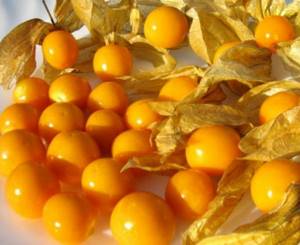
Physalis peruviana
What to follow?
There are related forms of home decor that are not clearly colors. For example, fabric paintings with relief elements, as a fashionable design trend. And if you prefer such a finish, you need to decide for yourself whether it is possible to keep artificial flowers of this variety at home. Or it is necessary to compensate for the negative factor with living plants.
Is it possible to keep artificial flowers at home according to Feng Shui? Ancient Chinese teaching emphasizes the color rather than the life of the flower. A red or orange object must be present to activate the chi. According to the Eastern sages, an artificial flower is
On Christmastide, the temple is decorated with inanimate decorations. The question arises, why can’t you put artificial flowers at home if this is acceptable in church? The answer is simple: the image of inanimate decorations is associated with ritual ceremonies, so decorating home space with them is considered unfavorable.
How to choose and save physalis
When choosing bladderwort fruits, color is important: it should be rich, most often yellow or orange. Although purple fruit varieties have now been developed. The shell of the berries must be intact, elastic, and without damage.
When choosing an exotic fruit, you should remember about the varietal diversity and taste characteristics of the fruit.
The fruits are stored in a cool, ventilated area with moderate humidity. Exotic fruit can be stored in the refrigerator on the bottom shelf with air access.
Proper storage conditions for fruits will allow you to consume bladderwrack fruits fresh for two months.
What happens in a prosperous home?
In a family where joy radiates and love is present, artificial flowers for home interiors take on positive energy and become consumers of the kindness of the residents, leaving nothing in return.
If at first they were used in a bad house, and then got to another owner, then they can give off negativity and poison the home atmosphere. Thus, a source of “evil spirits” appears.
According to signs and superstitions, artificial flowers in the house do the most harm in the bedroom. For a couple relaxing in such a room, they foretell separation. For a lonely person, they increase the feeling of emptiness and disappointment, and his personal relationships will not take place.
"Bad" houses
How good or bad are artificial flowers in a house where scandals and quarrels are frequent? In fact, for a dysfunctional home with a gloomy atmosphere, absorbent and cleansing “funnels” are very useful.
Just don’t leave them for long so that the absorbed energy doesn’t start coming back. There comes a time when jewelry is unable to absorb more negativity. After a month they need to be removed from the house. But if you don’t want to part with the “beauty,” you should use energetic cleansing of objects so that you can keep them with you.
The benefits and harms of physalis
Benefit.
- Physalis contains vitamin C, nicotinic acid, and B vitamins.
- Physalis removes water from the body, relieves swelling, regulates cholesterol levels
- Physalis contains dietary fiber and is also low in calories
- Physalis fights for beauty, health and youth!
Harm.
You should not use physalis for acute stomach diseases, kidney diseases and low blood pressure. Allergic reactions are also possible
Decorative types of physalis are unsuitable for food! Their difference is that the fruits are very small and bitter.
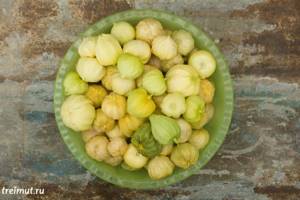
Dangerous decorations
Types of popular artificial plants at home:
- A frequent preference of modern housewives is ivy or climbing plants along the walls. Such decorations are categorically not recommended in the living space: they attract illness to the owner of the house.
- Synthetic reed is the most unfavorable type of plant for the home, as it provokes serious diseases. Ivy has the same effect.
- Is it possible to keep artificial flowers made of wax at home? It is not advisable to store them in a residential area. It is believed that sooner or later even candles in the shape of flowers will lead to death.
According to popular belief, you should not accept artificial flowers for home decoration as gifts, especially from strangers, because through them negative energy can be transmitted and affect the owner’s condition. Such things have long been used by ill-wishers to convey the evil eye, slander, and get rid of illness.
Other floral signs
Almost every house and village hut was decorated with plants. This was one of the inexpensive and affordable decor for everyone. Now many people prefer and love home flowers and try to make their apartment “green”. This is also facilitated by the teachings of Feng Shui, which encourages a large number of plants in the home.
You should not keep wilting plants in the house. They say they take away positive energy. When the bouquet in the vase did not last as long as expected, get rid of it. This also applies to indoor plants that live in pots. Withered and dried parts are cut off, and the dead ones are taken away from the house.
You cannot pick up abandoned flowers that are lying on the street. In some regions there is a custom to sprinkle fresh flowers on the path to the cemetery for the deceased. Therefore, picking up a flower lying on the ground means bringing death upon yourself.
In the theater they do not decorate the stage with fresh flowers; they use only artificial ones. According to the sign, on a stage with living plants the performance will be unsuccessful.
Red roses and generally flowers of this shade cannot be given for a wedding. But when you receive such a gift from your lover, it means an imminent wedding and symbolizes the seriousness of your intentions. White flowers, which are given for a wedding, when presented not by the husband, are also for the wedding.

Forget-me-nots on the windowsill in the marital bedroom preserve feelings and protect relationships from quarrels, misunderstandings and betrayals. And spathiphyllum and anthurium are paired plants, which is good to give to newlyweds. These are symbols of a happy family life, good luck and wealth.
You can read about all the plants for your home on the website. Some of them are energy vampires, while a number of them attract good things - wealth, fidelity, happiness.
The main thing is not to mindlessly follow signs, but to listen to your own feelings. When signs say that this is a good option for a plant, but you don’t like it, don’t act contrary to yourself. This also applies to the reverse situation.
When purchasing another flower, we do not even know about some of the harmful properties of indoor plants, and then suddenly we notice emerging health problems. If a small child or animals live in the house, then you need to pay special attention to the choice of indoor flowers and plants in order to protect their livelihoods. Some types of plants contain poison in their sap or release harmful substances into oxygen.
In addition to plants that are not recommended to be kept at home, some flowers have an adverse effect on the human body. In this case, you need to choose the right location for the future green resident, without placing it in the bedroom or, conversely, in the kitchen.
There are a huge number of disputes and disagreements about dangerous plants in the house. All the sayings are mixed with various signs that can ultimately confuse a novice gardener. In this article we will look at plants with which you need to be careful and be aware of the likely consequences for the body and for energy.
Energy cleaning of flowers
You need to collect all the flowers and place them in a vase on an empty table. Light twelve candles around the vase, placing them at equal intervals. You need to prepare red thread, holy water and light candles. Moving clockwise, you should say words like these: “Flowers collect evil in a circle, do not return it back, destroy all evil with fire.”
The candles must burn out on their own, the flowers must be removed from the vase, tied with red thread, put back, and sprinkled with holy water. Such energy cleansing is enough once every six months.
Methods for growing Physalis
In warm regions, Physalis seeds can be sown directly in open ground. It is best to use fresh seeds, although seed germination lasts 3-4 years.
Growing seeds in open ground
Before sowing, it is recommended to place the seeds in a 5% saline solution. Any seeds that float should be discarded. The remaining seeds are washed in clean water and then placed in a manganese solution for half an hour.
It is necessary to sow the seeds at a certain distance, and when the sprouts sprout, they should be thinned out, leaving a distance of 30 cm from each other.
Sowing seeds can be done both in spring and autumn.
Sowing seeds for seedlings
In the middle zone, it is better to grow Physalis as seedlings. Sowing of seeds is carried out in March. To grow seedlings, you can use separate cups or a seedling box, but then the seedlings will need to be picked. The optimal air temperature for seed germination is +20°C. If the air temperature is lower, seed germination will be delayed.
Carefully ensure that the soil is slightly moist, but that water does not stagnate, otherwise the seedlings may get sick.
If the seedlings are weak and stretch out a lot, although the temperature regime is maintained and the lighting is good, then the seedlings can be fertilized with a weak solution of bird droppings (in a ratio of droppings to water of 1:20).
Seedlings are planted in the soil when they have 5 true leaves.
Cuttings
A simple vegetative way of growing decorative perennial Physalis is to separate the lateral shoots from the bush and plant them in the ground.
Cuttings are harvested in the summer. To do this, the tops of the shoots, which have at least two nodes, are cut off, after which they are planted in light fertile soil, covered with film. After the leaves of the cuttings become elastic again, the film is removed. It is important that the cuttings are kept in the shade until they are completely rooted.
Alternative
An acceptable option according to popular belief is dried flowers. But they should not be withered or dead, but must be carefully dried and presented in the form of a composition.
It is not for nothing that the custom of hanging dry wreaths and bouquets of field plants in the house was so widespread among peasants. They were successfully used as amulets. There were also undesirable types of flowers: feather grass, for example, took away the strength of the head of the family, for which it received the second name “widow’s grass.”
If, despite beliefs and signs, the choice nevertheless fell on artificial flowers, you should prefer shades that are close to natural: they look nobler than “acid” ones. It will be better if the flowers are made of silk or cotton rather than polyurethane or latex. And to prevent decorations from losing their bright color, you should not place them on windows in direct sunlight. You can carefully remove dust from the petals and stems with a stream of water, a brush or a hairdryer.
Description of the plant and its beneficial properties
Physalis is a berry-shaped fruit that is covered with a thin shell that looks very similar to a paper Chinese lantern. That is, the structure of the fruits resembles berries, although in taste they are close to vegetables.
This plant is a perennial, annually sprouting new erect shoots with a slightly curved shape. Their height reaches one meter. Physalis has a powerful branched root system with creeping shoots, so it grows in large bushes. The flower is bell-shaped, from light yellow to deep orange or red. It is in it that the berries ripen; at first they are green, and as they ripen they acquire a bright yellow or orange color. The berries are fleshy, with numerous seeds arranged in a chaotic manner. The fruits are similar in appearance to cherry tomatoes. Their taste is sweet with a slight hint of sourness and a slight, subtle bitterness, but this adds a special piquancy to the berry.
Physalis is an unpretentious plant; it does not require special attention and care, but at the same time gives a good harvest.
Decorative varieties have much more bitterness in their fruits, so they are not used for food, but they adequately fulfill their decorative function in ikebana and autumn bouquets.
Edible (vegetable or berry) varieties are valued precisely for their taste, therefore they are used in the cuisine of many peoples of the world.
The berries are canned, various sauces and marinades are prepared from them, they are used as a filling for desserts, and physalis juice is a special seasoning for meat and fish dishes.
But the main advantage of this plant is its medicinal properties. Fruits, seeds, leaves and roots contain many substances beneficial to the human body.
Physalis contains:
- vitamins A and B;
- oily substances;
- organic acids that have a beneficial effect on the acid-base balance, thereby normalizing its indicators;
- carbohydrates and fats;
- ash;
- an alkaloid that gives the fruits a piquant bitterness;
- tannins, thanks to which the plant has antimicrobial and anti-inflammatory properties;
- ascorbic acid;
- steroids, physalis leaves are especially rich in them;
- pectin, which also ensures the removal of toxins, cholesterol, and heavy metals from the body;
- lycopene, also a natural colorant and antioxidant;
- minerals;
- phytoncides;
- protein;
- antihistamine and diuretic substance – quercin;
- fiber and, of course, water.
Thanks to this unique composition, physalis is widely used for medicinal purposes, as it has a beneficial effect on the body.
And so, the plant is known for its antiseptic and hemostatic properties. In addition, decoctions of berries and leaves are an excellent diuretic and choleretic agent, which also removes sand and small stones from the kidneys and bladder.
In addition, physalis in the form of a decoction has an analgesic effect and is used in the treatment of rheumatism, bronchitis, various lichens, and respiratory diseases.
Regular intake of a decoction of the roots normalizes the menstrual cycle in women. And fresh juice treats dermatitis.
Physalis is recommended to be consumed as a preventative against cancer.
Vegetable varieties of physalis are recommended even by traditional medicine. They contain a sufficient amount of vitamins, so sometimes they can easily replace a pharmacy vitamin complex.
The fruits are recommended to be eaten as a dietary food for stomach ulcers, gastritis, chronic cholecystitis, as well as for hypertension, inflammatory processes of the duodenum.
Ripe berries are suitable for treatment; up to eight of them are eaten at a time, half an hour before meals.
Medicinal decoctions are prepared from roots, leaves, and berries.
Infusions and ointments are also prepared from the berries.
